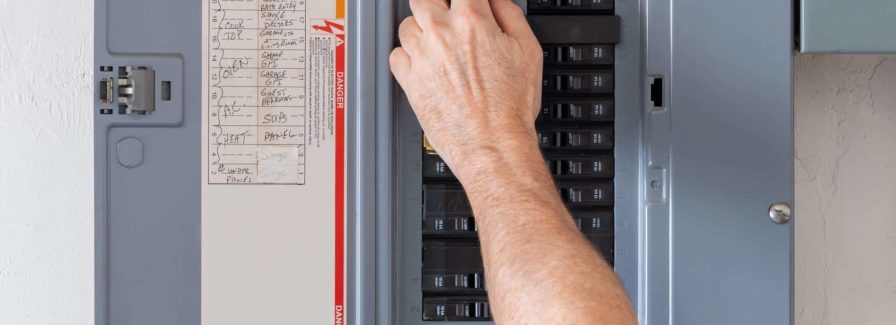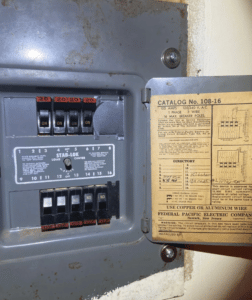
Posted on September 6, 2022 by Duval Home Buyers in Uncategorized
Do I need to rewire my house to sell it?
Electricity in our homes is something that we often take for granted. Bad storms aside, when you flip a lightswitch, the lights come on. But behind the scenes lies a complex electrical system ensuring power when you want it while also keeping your home and your devices safe. Electricity is no joke, and poor insulation, damaged wiring, or overloaded circuits can cause damage, destruction, and even death.
Because of this risk, you may have difficulty selling your home if you have old or damaged electrical wiring. Lenders and insurers have strict requirements around electrical systems, and you may even need to rewire your home before you sell it. Here’s how to be sure.
Determining what kind of wiring your home has
The first step to fixing a problem is always identifying the problem to begin with. If you have a newer home, one built well after 1960, chances are your home’s wiring is up to modern code using NM cable and you won’t need to do anything to fix it.
However, if your home is an older home built in the 60s or before, you may have an electrical system built to an outdated code, and you may need a rewiring project in order to successfully sell your house. The best way to be sure is by hiring a licensed electrician to examine your electrical system. They can determine the type of material used to wire your electrical system. If they determine that your home is using cloth wiring, knob and tube wiring, or aluminum wiring, you may need to replace it and install new wiring.
The reason that this wiring causes issues is often that besides the added risk of fires and shorts, it also doesn’t support a ground wire, which is required for modern three-pronged outlets.
Amperage matters
Amperage in simple terms is the strength of an electrical current measured in amperes or amps. As technology has improved our reliance on electricity has grown, and while many devices and appliances have taken steps to greatly reduce their power consumption, we still require far more current than we used to to power our homes.
Historically homes were built for 60 AMP service. It wasn’t until the 1970s that 60 AMP service was replaced with 100 AMP service, and the 1980s when the modern 200 AMP service we use today became commonplace.
If your home is still wired for 60 or 100 AMP service it won’t be able to meet modern power consumption demands and should be rewired. You may get lucky and find a home buyer that doesn’t care, but most people want to be able to run all of their devices without having to micromanage connections.
Your panel box can be part of the problem
Your home has a circuit breaker panel or electrical service panel, which is the main connection point to the outside line and is used to monitor and close circuits in the event of an overload. Most homeowners have seen this panel, and may have even had to flip a breaker. But did you know that this panel can be a huge red flag to buyers and lenders?
There are a few types of panels which are no longer up to code, or have been recalled which may need to be swapped out. For instance old bulb style panels are difficult to safely interact with and many modern technicians don’t know how to perform maintenance on them. If you have this type of panel you should expect to exchange it before listing your home.
Additionally, in the 1960s and 1970s many homes were built with Federal Pacific or Zinsco electrical panels believed to be safer than the previous bulb style. However, modern inspectors have found that many times these panels will fail to trip a breaker in the event of an overload. This presents a significant fire hazard. As such, these panels were recalled and must be replaced for both lender requirements and the safety of the occupants.
Above: A Federal Pacific Panel
Outlets and switches are also an issue
Less a lender and safety requirement and more of a selling feature, the number and type of available electrical outlets is a huge consideration for potential buyers. While homes built after 2008 are required to have modern 3 prong grounded outlets, many older homes still utilize the groundless two pronged design.
You may find a mix of the two, or even just two pronged outlets on homes built before the 1980s. Because a majority of common appliances use three prong outlets today it’s very unlikely that a house with a majority or all of the outlets having two prongs will sell for top dollar.
A licensed electrician can advise on the feasibility of replacing your two pronged outlets with three pronged outlets, and can ensure all switches and wall plates are installed up to code.
How much does it cost to rewire a house?
If it is determined that you need to rewire your home, the cost varies depending on the size of the home and the type of electrical work being done. On average it costs $12,000-$20,000 to rewire a 2,000 square foot home including labor and materials. Your electrical may have to open walls to run wires, which could add additional repair expenses to the job.
Selling a home without rewiring
It is possible to sell a home without rewiring or upgrading your electrical system even if you find that you have old wiring, the wrong amperage, a bad panel box, or two pronged outlets. However, a majority of these buyers would need to use cash because of lender restrictions, making it difficult to find a buyer through traditional channels.
The most common type of cash buyer who can purchase your home without your needing to rewire it is a cash buyer or investor. They can help you save money on rewiring your home by selling it as-is, bad wiring included, usually in as low as 7 days. Otherwise, you are better off paying for the electrical job before listing and selling the traditional way.

